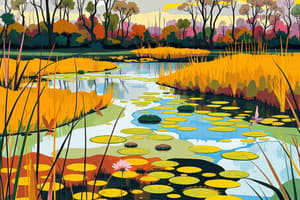Podcast
Questions and Answers
What are the three indicators that define a wetland?
What are the three indicators that define a wetland?
- Temperature, precipitation, and humidity
- Rocks, sand, and water
- Vegetation, soil, and hydrology (correct)
- Insects, birds, and mammals
Which are the five ecological systems (or water regimes) in which wetlands may be found in Maryland?
Which are the five ecological systems (or water regimes) in which wetlands may be found in Maryland?
- Alpine lakes, desert oases, lagoons, hot springs, and geysers
- Mangrove forests, coral reefs, seagrass beds, kelp forests, and rocky shores
- Glaciers, ice caps, icebergs, ice shelves, and ice floes
- Tidal freshwater marshes, tidal brackish marshes, saltwater marshes, cypress swamps, and riparian wetlands (correct)
What are the six indicators of wetland hydrology?
What are the six indicators of wetland hydrology?
- Groundwater level, river flow, lake depth, snowmelt, ice cover, and precipitation
- Tides, waves, currents, salinity, temperature, and dissolved oxygen
- Sunlight, temperature, wind speed, cloud cover, humidity, and air pressure
- Inundation, soil saturation, oxidized rhizospheres, water marks, drift or scour lines, and sediment deposits (correct)
What is the most common wetland ecological type in Maryland?
What is the most common wetland ecological type in Maryland?
In which region of Maryland are the greatest acres of forested wetlands found?
In which region of Maryland are the greatest acres of forested wetlands found?
How is peat formed?
How is peat formed?
What defines peatlands, bogs, mires, moors, or muskegs?
What defines peatlands, bogs, mires, moors, or muskegs?
What percentage of Maryland's wetlands are represented by estuarine wetlands?
What percentage of Maryland's wetlands are represented by estuarine wetlands?
Flashcards are hidden until you start studying
Study Notes
Wetland Indicators
- Three indicators defining a wetland: hydrology (presence of water), hydric soils (saturated or flooded conditions), and hydrophytic vegetation (plants adapted to wet conditions).
Ecological Systems in Maryland
- Five ecological systems (water regimes) for wetlands in Maryland:
- Palustrine (non-tidal wetlands)
- Riverine (wetlands along rivers)
- Lacustrine (wetlands adjacent to lakes)
- Estuarine (wetlands at the interface of freshwater and saltwater)
- Tidal (wetlands influenced by tides)
Indicators of Wetland Hydrology
- Six hydrology indicators include:
- Surface water presence (evidence of flooding)
- Soil saturation (waterlogged conditions)
- Water-stained vegetation (indications of prolonged saturation)
- Drainage patterns (evidence of water flow)
- Aquatic organism presence (species relying on wetland conditions)
- Microtopography features (small landscape variations indicating water presence)
Common Wetland Ecological Type
- The most common wetland ecological type in Maryland is palustrine wetlands.
Forested Wetlands in Maryland
- The greatest acres of forested wetlands in Maryland are found in the western region of the state.
Peat Formation
- Peat forms through the accumulation of decomposed plant material in waterlogged conditions, leading to partial decomposition due to anaerobic bacteria.
Definitions of Peatlands
- Peatlands, including bogs, mires, moors, and muskegs, are characterized by high organic material accumulation, saturated conditions, and distinct vegetation types adapted to wet environments.
Estuarine Wetlands in Maryland
- Estuarine wetlands comprise approximately 30% of Maryland's total wetland area.
Studying That Suits You
Use AI to generate personalized quizzes and flashcards to suit your learning preferences.




